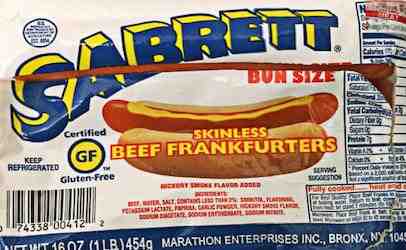What is salami made out of?

Salami is a sausage made from fermented and/or air-dried meat. On the same subject : Are hot dogs made out of pig snouts?. Traditionally, salami was made from pork, although today it is made with all kinds of meat or game – beef, lamb, duck, venison, even horse or donkey – or a mixture of any of them. of the above items.
Is salami a healthy meat? Nutrition. Salami is low in carbohydrates and calories, but high in protein, fat and sodium. It also contains a good number of several other vitamins and minerals, including vitamin B12, thiamin, niacin, and zinc.
What part of the pig is salami?
Traditionally made with pork belly, it is salted and seasoned with herbs and spices. On the same subject : Is there plastic in hot dogs?.
What part of the animal is salami?
| winter salami | |
|---|---|
| Type | Sausage |
| Place of origin | Southern, Eastern and Central Europe |
| The main ingredients | Fermented and air-dried pork |
| Cookbook: Salami Media: Salami |
What part of the cow is salami made of?
Various preparation techniques and recipes contribute to the vast varieties of salami. Salami is traditionally made with pork, but some varieties can be made with beef, venison, poultry, or other meats. The meat is tossed with fat, then tossed with herbs and seasonings, such as salt, garlic, or vinegar.
What is salami made from?
Salami is a sausage made from fermented and/or air-dried meat. This may interest you : Is sausage casing made from intestines?. Traditionally, salami was made from pork, although today it is made from all kinds of meat or game – beef, lamb, duck, venison, even horse or donkey – or a mixture of anything precedes.
Is salami made from donkey meat?
| State | Italy |
|---|---|
| Region | Veneto |
What is normal salami made of?
A traditional salami, with its typical marbled appearance, is made from beef or pork (sometimes specifically veal). Beef is usual in halal and kosher salami, which never includes pork for religious reasons. Manufacturers also use other meats, including game and poultry (mainly turkey).
What is the white stuff in salami?
Q: WHAT IS THE WHITE PLUG ON THE OUTSIDE OF MY SALAMI? The salami casing is covered with a powdery layer of mild white mold, which is removed before eating. This is a “good” type of mold, which helps to cure the salami and repel bad bacteria.
Can I eat the white stuff on salami?
The powdery stuff on your salami is mold, but it’s the right kind of mold, and it’s completely edible. We get this question often, and it’s usually in a frantic tone because, well, bad mold can be harmful.
What is the hard white stuff in sausage?
White powder can mean many things, but the most likely answer is white mold. People usually associate mold with negative things, but white mold on sausages is a good sign. It appears on the surface of sausage casings during the curing process.
Are hot dogs made out of Buttholes?

A recent study by Canadian pathologists attempted to find out if the dark legend is true. The good news is that hot dogs don’t appear to be made from “oral and anal scaly mucosa,” as they are called in medical parlance. The bad news is that the actual hot dog ingredients don’t rank much better.
What are hot dogs really made of? What are hot dogs made of? Hot dogs are made from emulsified meat trimmings of chicken, beef, or pork. This meat mixture is mixed with other ingredients (like preservatives, spices, and colorings) into a batter-like substance.
Do they put Buttholes in hotdogs?
FYI, no, hot dogs don’t contain anuses. But pork anus may seem like a more appetizing option compared to the latest hot dog charge.
Are hot dogs still made with intestines?
When cellulose casings are used, the hot dogs are the exact size and weight. They are vacuum sealed in plastic wraps to protect the freshness and flavor of the hot dog. Since the casings of natural casings are made from cleaned and processed animal intestines, they are similar in size, but not exact.
Are there genitals in hot dogs?
No matter what you may have heard, there are no ears, muzzles, or genitals in your hot dogs. So what is it? Hot dogs can be made from the edible parts of beef, veal, lamb, pork, or poultry. This can include the tongue, heart, esophagus, and blood.
What animal is beef from?

The meat from a cow is commonly known as beef. However, if the beef comes from a young cow, it is usually called a veal. Similarly, the meat of an adult sheep may be called mutton, while the meat of a young sheep is usually called lamb.
Is beef cow meat? beef, meat of adult cattle, as opposed to veal, meat of calves. The best beef is obtained from special breeds of early maturing beef.
Is beef from cows or bulls?
Beef, however, is the culinary name for bovine meat, in the sense that beef comes from cattle, excluding cows, as well as bull. What is that? Beef is raised from male and female cattle. However, the females remain heifers and continually breed to produce calves for dairy and to be slaughtered for meat.
Are bulls used for beef?
Bulls are generally not used for meat. Bulls are not castrated because they have desirable traits that producers want to use for breeding. Typically, a bull will produce more calves in its lifetime than a cow, according to Extension beef cattle specialist John L. Evans, Ph.
Are cows used for beef?
Beef cattle are cattle raised for meat production (as opposed to dairy cattle, which are used for milk production). Meat from mature or nearly mature cattle is primarily known as beef. In beef production, there are three main stages: cow-calf operations, backgrounding, and feedlot operations.
Where does beef come from?
Beef is the culinary name for bovine meat (Bos taurus). In prehistoric times, humans hunted aurochs and then domesticated them. Since that time, many breeds of cattle have been bred specifically for the quality or quantity of their meat.
Does beef come from steers or cows?
steer, also called steer, a young castrated male bovine raised primarily for beef. In the terminology used to describe the sex and age of cattle, the male is a bull calf first and, if left intact, becomes a bull; if he is castrated, he becomes an ox, and about two or three years old becomes an ox.
What’s in all beef hot dogs?

Beef, water, corn syrup, contains 2% or less: salt, potassium lactate, hydrolyzed beef broth, natural flavor (including celery juice powder), sodium phosphate, sea salt, sodium diacetate, extractives of paprika. *except those naturally present in sea salt and celery juice powder.
What are all the ingredients in hot dogs? Ingredients
- Meat trimmings and fat, e.g. mechanically separated meat, pink slime, meat porridge.
- Flavorings, such as salt, garlic and paprika.
- Preservatives (cure) – usually sodium erythorbate and sodium nitrite.
Are all beef hot dogs good for you?
The answer: hot dogs aren’t exactly nutritious – not even close. They are made with processed meat and are loaded with cholesterol-raising saturated fat and sodium. The good news: If you read nutrition labels, you can find sausages that are kinder to your waistline and arteries. (Yet healthy foods are not.)
Is all-beef hot dog healthy?
The report concluded that every 50 gram slice of processed meat consumed daily – equivalent to about a hot dog – was linked to a 16% increased risk of colorectal cancer. (The International Agency for Research on Cancer classifies all processed meats as carcinogens.)
Are all-beef hotdogs unhealthy?
Regardless of moderation, hot dogs aren’t exactly healthy. The World Health Organization’s International Agency for Research on Cancer (IARC) has reported that ham, hot dogs and other processed meats may contribute to colorectal cancer. Hot dogs are also high in saturated fat and sodium.
What is pink slime in hot dogs?

Pink slime, aka lean fine-textured beef (LFTB), is used as a topping in some frozen entrees, meatballs, canned foods, hot dogs, and fast food, for example. But LFTB has become most notorious for its role in ground beef.
Is pink slime real meat? What is Pink Slime? “Pink slime” is a type of ground beef that has been treated with ammonia to prevent bacteria from forming. The process begins with cuttings and trimmings from cattle carcasses that are cut into small steaks and sent back to be made into ground beef.
What does pink slime do to the body?
Pink Slime is injected with ammonium hydroxide gas. James Dickson, a professor at Iowa State University, says, “The gas actually kills a lot of harmful bacteria that might be there. It is important to remember that meat is not sterile.
What is pink slime made up of?
“Pink slime” refers to processed lean beef trimmings and is a cheap filler used to “reinforce” many meat products. It is made by salvaging meat that is cut from pieces of beef with fat.
Is pink slime harmful to humans?
But the truth about pink slime is that, despite its unappetizing name, it’s completely safe to eat. More than that, it’s an affordable source of lean meat for low-income Americans, and its stigma hurts people who depend on it for protein.
Is pink slime still used in hamburger?
Pink slime, the infamous amorphous filler that was revealed to be a key component of cheap ground beef used by fast-food chains like McDonalds in 2012, is back. Following a recent review by the USDA, the substance is now legally permitted to be called “ground beef” on food packaging and labels.
Does Taco Bell still use pink slime?
McDonald’s, Taco Bell and Burger King announce that they no longer use pink slime in their dishes.
Did McDonalds stop using pink slime?
Like many in the industry, McDonald’s has stopped using “pink slime” (ammonia-treated lean beef trimmings) in its burgers, but questions about its use persist. The videos are the latest move in McDonald’s campaign to highlight the quality of its food amid continued questions about its ingredients.
Is pink slime safe to eat?
But the truth about pink slime is that, despite its unappetizing name, it’s completely safe to eat. More than that, it’s an affordable source of lean meat for low-income Americans, and its stigma hurts people who depend on it for protein.
Is pink slime FDA approved?
The use of ammonia as an antimicrobial agent is approved by the Food and Drug Administration and listed as a GRAS (generally recognized as safe) procedure by the FDA, and is used in similar applications for many other food products, including puddings. and baked goods.
Is pink slime toxic?
Yes, pink slime is safe thanks to this chemical. James Dickson, a professor at Iowa State University, says, “The gas actually kills a lot of harmful bacteria that might be there.
Is human meat found in hotdogs?
No, hot dogs do not contain human meat.
Are there humans in hot dogs? The Clear Labs hot dog study found human DNA samples in 2% of 345 hot dogs and sausages. Two-thirds of this human DNA has been found in vegetarian hot dogs.
Is there organ meat in hot dogs?
Varied meats or organ meats are generally not used in hot dogs or sausages and if organs are used, the specific organ will be included in the ingredient declaration on the package and the front of the package will state ” with various meats” or “With meat by-products.”
Do hot dogs contain organs?
In reality, most hot dogs you find in a grocery store, and especially national brands, contain nothing close to organs. According to the USDA, hot dogs must be made of meat or poultry and may contain more than one type of meat.
What parts of meat are in a hot dog?
Most of the time, hot dogs are made with skeleton meat, which are trimmings of the same type of meat that makes ground meat, steaks, and roasts. The fillings are ground very finely, which gives them this homogeneous texture. Salt is added to the meat, giving the mixture a sticky texture.
What meat is actually in a hot dog?
Pork and beef are the traditional meats used in hot dogs. Cheaper hot dogs are often made from chicken or turkey, using low-cost mechanically separated poultry.
What parts of the animal are in hot dogs?
According to the Food and Agriculture Organization of the United Nations (FAO): “The raw meat materials used for pre-cooked products are low-grade muscle trimmings, fatty tissues, head meat, animal feet, animal skin, blood, liver and other edible by-products of slaughter.”
What body parts are in hotdogs?
According to the Food and Agriculture Organization of the United Nations (FAO): “The raw meat materials used for pre-cooked products are low-grade muscle trimmings, fatty tissues, head meat, animal feet, animal skin, blood, liver and other edible by-products of slaughter.”
What parts of a cow are in a hot dog?
Beef trimmings are the excess cuts of beef made when meat producers create cuts of beef such as steaks, ribs, or brisket. These trims are still high quality, but they are not sold in this condition because the parts are too small and not uniform in size. These pieces are used to make hot dogs.
Are there bones in hot dogs?
Hot dogs are made of “mechanically separated meat”, defined by the United States Department of Agriculture as “a batter-like and batter-like meat product produced by forcing bones with edible meat attached under high pressure through a sieve or similar device.
Sources :
